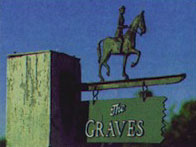|
|
|
|
|
|
|
|
|
|
|
|
|
|
|
|
|
|
|
|
|
|
|
|
|
|
|
|
|
|||||||||||||||||||
|
|
|
|
|
|||||||||||||||||||
|
|
|
|||||||||||||||||||||
|
|
|
|
|
|
||||||||||||||||||
|
|
|
|||||||||||||||||||||
|
|
Recollections |
|
||||||||||||||||||||
|
From the Spiraldynamics website... Dr. Graves and his wife, Marian, lived on a picturesque little farm in the upper Hudson Valley, only a few miles from the historic Mohawk River and the ErieCanal during the time of his research. They had a pond, a couple of trotting horses, and a big, feisty, spoiled black cat with no name. Their two children were grown and had their own families, but continued living nearby.
Dr. Graves retired early from teaching because of sudden health problems and, though his body could not manage the rigors of a daily schedule, his mind was as sharp as ever and hungry to apply his "point of view" to the problems of human existence. As he often said, some people are born with brains "out of their time." He certainly seems to have been such a one. Today, his thinking is cutting edge and fast becoming mainstream. But as recently as the late 1970's, his ideas about the development of human nature were a step beyond. Though he retired from Union College as Professor Emeritus, Graves' began as a relatively obscure teacher of psychology in the years following World War II. As often seems to happen, wartime energy and post-war euphoria served as breeding grounds for visionary thinking and bold, new breakthroughs in human knowledge. Such was the case with Graves. In the early 1950's, at the end of a semester of exploring theories of personality and human development, he found himself confronting a question he could not answer: "OK, professor. Now we know Maslow and Rogers and Skinner and lots of others. Which theory is right? Which one accurately depicts the development of human nature?" He couldn't answer the question and, rather than continue to rehash older psychological constructs or participate in the debates between the conflicting theories of the day, he decided to start afresh by searching for the reasons behind shifting views of human nature.
|
|
|||||||||||||||||||||
|
|
|
|||||||||||||||||||||
|
|
|
|
|
|
|
|
|
|
|
|
|
|
|
|
|
|
|
|||||
|
|
|
|||||||||||||||||||||
|
|
|
|
|
|
|
|
|
|
|
|||||||||||||
|
|
|
|||||||||||||||||||||
Copyright 2001 NVC Consulting



